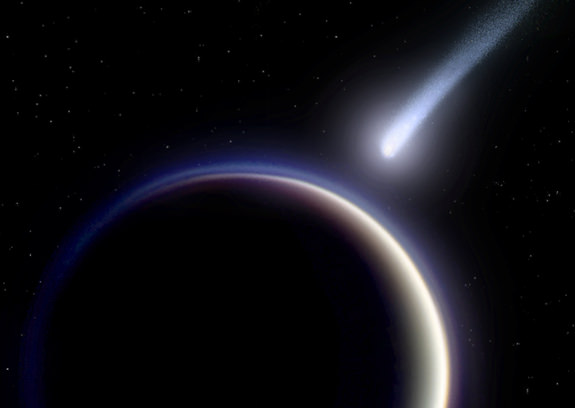[/caption]
Titan is a fascinating world to planetary scientists. Although it’s a moon of Saturn it boasts an opaque atmosphere ten times thicker than Earth’s and a hydrologic cycle similar to our own – except with frigid liquid methane as the key component instead of water. Titan has even been called a living model of early Earth, even insofar as containing large amounts of nitrogen in its atmosphere much like our own. Scientists have wondered at the source of Titan’s nitrogen-rich atmosphere, and now a team at the University of Tokyo has offered up an intriguing answer: it may have come from comets.
Traditional models have assumed that Titan’s atmosphere was created by volcanic activity or the effect of solar UV radiation. But these rely on Titan having been much warmer in the past than it is now…a scenario that Cassini mission scientists don’t think is the case.
New research suggests that comet impacts during a period called the Late Heavy Bombardment – a time nearly 4 billion years ago when collisions by large bodies such as comets and asteroids were occurring regularly among worlds in our solar system – may have generated Titan’s nitrogen atmosphere. By firing lasers into ammonia-and-water-ice material similar to what would have been found on primordial Titan, researchers saw that nitrogen was a typical result. Over the millennia these impacts could have created enough nitrogen to cover the moon in a dense haze, forming the thick atmosphere we see today.
“We propose that Titan’s nitrogen atmosphere formed after accretion, by the conversion from ammonia that was already present on Titan during the period of late heavy bombardment about four billion years ago.”
– Yasuhito Sekine et al., University of Tokyo, Japan
This model, if true, would also mean that the source of Titan’s nitrogen would be different than that of other outer worlds, like Pluto, and even inner planets like our own.
See the published results in the journal Nature, or read more on NewScientist.com.
Top image is a combination of a color-composite of Titan made from raw Cassini data taken on October 12, 2010 and a recolored infrared image of the comet Siding Spring, taken by NASA’s WISE observatory on January 10, 2010. The background stars were also taken by the Cassini orbiter. NASA / JPL / SSI and Caltech/UCLA. Edited by J. Major.
Note: the image at top is not scientifically accurate…the comet’s tail would be, based on the lighting of Titan, pointing more to the ten o’clock position as well as forward toward the viewer’s left shoulder. This would make it ‘look’ as if it were going the opposite direction though, away from Titan, and so I went with the more immediately decipherable version seen here. To see a more “realistic” version, click here.

